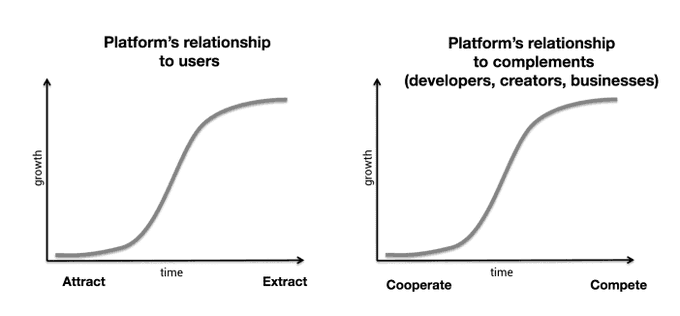Here is a brief explanation of Web 3.0 and why it is imperative today!
Web 1.0 (1990 – 2005):
Web 1 is assumed to happen during the period from 1990 to 2005. Web 1.0 was about open protocols that were decentralized and community-governed. Most of the value accrued to the edges of the network — users and builders.
Web 2.0 (2005 – 2020):
Web 2 is assumed to happen during the period from 2005 to 2020. Web 2.0 was about siloed, centralized services run by corporations. Most of the value accrued to a handful of companies like Google, Apple, Amazon, and Facebook.
Web 3.0 (From 2020):
Web 3.0 = Web 1.0 + Web 2.0
We are now at the beginning of the Web 3 era, which combines the decentralized, community-governed ethos of Web 1 with the advanced, modern functionality of Web 2.
Web 3 is the internet owned by the builders and users, orchestrated with tokens.
Why Web 3.0?
Problems with centralised platforms:
Centralized platforms follow a predictable life cycle. At first, they do everything they can to recruit users and 3rd-party complements like creators, developers, and businesses.
They do this to strengthen their network effect. As platforms move up the adoption S-curve, their power over users and 3rd parties steadily grows.

When they hit the top of the S-curve, their relationships with network participants change from positive-sum to zero-sum. To continue growing requires extracting data from users and competing with (former) partners.
Famous Examlpes are,
- Microsoft vs. Netscape
- Google vs. Yelp
- Facebook vs. Zynga
- witter vs. its 3rd-party clients
- Epic vs Apple
Stifling of Innovation:
For 3rd parties, the transition from cooperation to competition feels like a bait-and-switch. Over time, the best entrepreneurs, developers, and investors have learned to not build on top of centralized platforms. This has stifled innovation
Decentralized Ownership and Control:
In Web 3, ownership and control is decentralized. Users and builders can own pieces of internet services by owning tokens, both non-fungible (NFTs) and fungible.
Tokens:
Tokens give users property rights: the ability to own a piece of the internet.
NFTs:
NFTs give users the ability to own objects, which can be art, photos, code, music, text, game objects, credentials, governance rights, access passes, and whatever else people dream up next. NFTs exist on top of blockchains like Ethereum. Ethereum is a decentralized global computer that is owned and operated by its users. Blockchains are special computers that anyone can access but no one owns.
Ethereum:
Ethereum is powered by a fungible token, ETH, which is used to incentivize the physical computers that underlie the system. ETH is also the system’s native currency for transactions, like NFT purchases.
Ways to acquire Fungible and Non Fungible Tokens:
There are many ways for users to acquire fungible and non-fungible tokens. You can buy them, but there are also ways to earn them.
- Airdrop: Uniswap famously retroactively airdropped 15% of its governance tokens to early users of the protocol. Community grants like this have become common in Web 3 as a way to build goodwill and incentivize adoption.
- Creative and entrepreneurial activities: People are earning roughly $100M worth of ETH per day selling NFTs.
Solving the problem of Centralized Networks:
Tokens align network participants to work together toward a common goal — the growth of the network and the appreciation of the token. This fixes the core problem of centralized networks, where the value is accumulated by one company, and the company ends up fighting its own users and partners.
Conclusion:
Web 3 offers a new way that combines the best aspects of the previous eras. It’s very early in this movement and a great time to get involved. One of the leading examples of Web 3.0 is Bitclout, a decentralized social network operation on DeSo blockchain.
